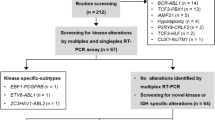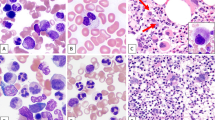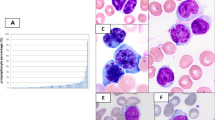Abstract
We report the cytogenetic, molecular and biological characterization of a case of B-PLL with a complex karyotype and concurrent abnormalities on the p53 and c-MYC genes. Conventional cytogenetics suggested that both 17q arms were translocated to chromosomes 1q and 14p, respectively, whereas both 17p arms were not identified. In addition, a Burkitt’s-like variant translocation t(2;8) was found. Study of loss of heterozygosity at 17p13 and p53 direct sequencing demonstrated the presence of only one copy of the p53 gene. A 27 bp deletion in exon 8 that resulted in the expression of a p53 protein lacking nine amino acids from the DNA binding region was also found. To confirm the presence of one copy of the p53 gene and localize it, fluorescent in situ hybridization (FISH) studies using a p53 gene probe was performed. Only one signal of p53 was visualized. Moreover, the DAPI profile of the chromosome containing the hybridization spot for the p53 probe did correspond to the cytogenetic marker identified as der(14)t(14;17). Whole chromosome 14 paint, centromere-specific for chromosome 17 and p53 gene probes were cohybridized to the preparations. This demonstrated that the der(14) contained the 17 centromere and distally the p53 gene suggesting that the der(14) contained the short arm of chromosome 17 with the breakpoint occurring in the long arm. FISH studies confirmed the involvement of c-MYCand KAPPA in the t(2;8) translocation. To our knowledge, this is the first case of B-PLL with inactivation of the p53 gene by mutation together with a Burkitt’s-like t(2;8) translocation involving the c-MYC gene. The cooperation of these genes may have conferred a growth advantage which was critical in the development of this aggressive form of B-PLL.
This is a preview of subscription content, access via your institution
Access options
Subscribe to this journal
Receive 12 print issues and online access
$259.00 per year
only $21.58 per issue
Buy this article
- Purchase on Springer Link
- Instant access to full article PDF
Prices may be subject to local taxes which are calculated during checkout
Similar content being viewed by others
Author information
Authors and Affiliations
Rights and permissions
About this article
Cite this article
Lens, D., Coignet, L., Brito-Babapulle, V. et al. B cell prolymphocytic leukaemia (B-PLL) with complex karyotype and concurrent abnormalities of the p53 and c-MYC gene. Leukemia 13, 873–876 (1999). https://doi.org/10.1038/sj.leu.2401416
Published:
Issue Date:
DOI: https://doi.org/10.1038/sj.leu.2401416
Keywords
This article is cited by
-
A new case of trisomy 5 with complex karyotype abnormalities in B-cell prolymphocytic leukemia: a case study
Egyptian Journal of Medical Human Genetics (2022)
-
Prolymphocytic Leukemia: New Insights in Diagnosis and in Treatment
Current Oncology Reports (2017)
-
Chronic lymphocytic leukemia and prolymphocytic leukemia with MYC translocations: a subgroup with an aggressive disease course
Annals of Hematology (2012)
-
B-cell prolymphocytic leukemia and chronic lymphocytic leukemia have distinctive gene expression signatures
Leukemia (2009)
-
Molecular cytogenetic characterization and clinical relevance of additional, complex and/or variant chromosome abnormalities in acute promyelocytic leukemia
Leukemia (2001)



